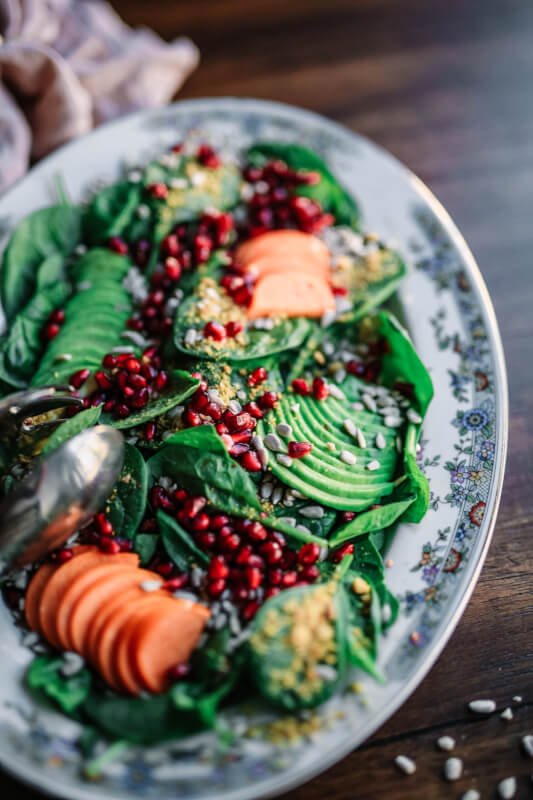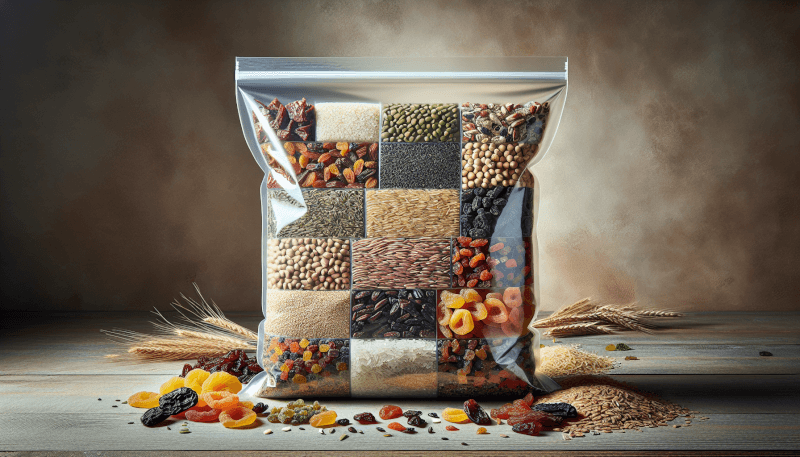Imagine never having to worry about your food going bad or getting spoiled again. With the help of Mylar bags, you can easily store your food and keep it fresh for an extended period of time. In this article, we will guide you through the simple and effective process of using Mylar bags for food storage. Don’t let your perishables go to waste – learn how to make the most out of Mylar bags and ensure your food stays delicious and nutritious for as long as possible.

Benefits of Using Mylar Bags for Food Storage
Mylar bags are a fantastic option for long-term food storage due to their numerous benefits. Let’s explore why using Mylar bags can be a game-changer for preserving your food.
Long-Term Preservation of Food
One of the most significant advantages of using Mylar bags is their exceptional ability to preserve food for an extended period. The durable material used in Mylar bags acts as a barrier against oxygen and moisture, keeping your food fresh for months or even years. This makes it an ideal choice for storing emergency supplies, bulk food purchases, or preserving garden harvests.
Protection Against Oxygen and Moisture
Oxygen and moisture are two notorious culprits when it comes to food spoilage. However, Mylar bags offer a reliable defense against these elements. The inner layer of the bag is made of polyester film, which acts as an impermeable barrier, preventing oxygen and moisture from entering and compromising the quality of your food. By keeping these harmful elements at bay, Mylar bags ensure that your food stays fresh and free from spoilage for an extended period.
Prevents Food Spoilage
Who hasn’t been disappointed by finding spoiled food in their pantry or refrigerator? Mylar bags can help put an end to those frustrating moments. By effectively sealing out oxygen and moisture, they create an inhospitable environment for the growth of bacteria, mold, and other spoilage-causing agents. This significantly reduces the likelihood of food spoilage, allowing you to enjoy your stored food for longer periods without any concerns about quality or safety.
Retains Nutritional Value
Preserving the nutritional value of your stored food is essential, and Mylar bags excel in this aspect as well. Unlike traditional plastic storage bags, Mylar bags provide an excellent barrier against light and oxygen, both of which can degrade the nutritional content of food over time. By keeping these factors in check, Mylar bags ensure that your stored food retains its vitamins, minerals, and overall nutritional value.
Cost-Effective Option
Many people shy away from long-term food storage due to the perceived costs involved. However, Mylar bags offer a cost-effective solution. Compared to other food storage options like vacuum-sealed containers or bottles, Mylar bags are significantly more affordable. They are also lightweight and space-efficient, allowing you to store a large quantity of food without taking up excessive storage space. With Mylar bags, you can save money while ensuring the long-term preservation of your food.
Choosing the Right Mylar Bags
Now that we’ve explored the fantastic benefits of Mylar bags for food storage let’s dive into the factors you should consider when selecting the right Mylar bags for your needs.
Types of Mylar Bags
There are various types of Mylar bags available in the market. Some are designed for single-use, while others are reusable. Additionally, there are different styles of Mylar bags, such as flat pouches, ziplock bags, or bags with gussets. Consider your storage requirements and preferences when choosing the type of Mylar bag that best suits your needs.
Thickness and Size Considerations
The thickness of Mylar bags plays a crucial role in their durability and ability to protect your food from external elements. Thicker bags offer better protection against punctures and tears. When selecting the thickness of your Mylar bags, consider the types of food you intend to store and the environment in which they will be stored. Additionally, choose appropriate sizes that accommodate the volume of food you wish to store while minimizing wasted space.
Quality and Material
Ensure that the Mylar bags you choose are of high quality. Look for bags that are FDA-approved and food-grade. These bags are designed specifically for food storage and have undergone strict quality checks to ensure their safety and durability. It’s also helpful to consider the clarity of the bags, as transparent bags allow you to easily identify the contents without opening them.
Zipper or Sealing Mechanism
Mylar bags come with different sealing mechanisms to choose from. Ziplock-style bags are convenient for quick access and resealing, allowing you to open and close the bag multiple times without compromising its effectiveness. On the other hand, heat-sealed bags offer a more secure and airtight seal, ensuring maximum protection for your stored food. Consider your storage needs and preferences when choosing the sealing mechanism that suits you best.

Preparing Food for Mylar Bag Storage
Once you’ve selected the right Mylar bags, it’s time to prepare your food for storage. Proper preparation ensures the longevity and quality of your stored food.
Selecting Suitable Foods
Not all foods are suitable for long-term storage in Mylar bags. For optimal results, choose foods that have a low moisture content and are non-perishable. Grains, beans, dried fruits, and powdered items are excellent choices. Avoid storing foods with high oil or fat content, as they can cause the bags to deteriorate more quickly.
Proper Food Packaging
Before placing your food in the Mylar bags, it’s essential to ensure that it’s properly packaged. Use appropriate food-grade containers to avoid any direct contact between the food and the Mylar bag. This extra layer of protection helps prevent punctures or tears in the bags, maintaining their integrity.
Removing Air and Maximizing Space
To ensure optimal preservation, it’s important to remove as much air as possible from the Mylar bags. Squeeze out excess air before sealing the bags tightly. Additionally, make sure to maximize the space within the bags to prevent unnecessary air pockets. This can be achieved by vacuum-sealing or using a straw to suck out the excess air.
Labeling and Dating
Properly labeling and dating your Mylar bags is crucial for efficient storage management. Clearly label each bag with the contents and the date of packaging. This will help you keep track of your inventory and ensure that you rotate your stored food properly to maintain freshness.
Using Oxygen Absorbers
Oxygen absorbers are a valuable addition to your Mylar bag storage system. Let’s explore their importance and learn how to use them effectively.
Importance of Oxygen Absorbers
Oxygen absorbers are small packets that remove oxygen from the surrounding environment. By introducing them into your Mylar bags before sealing, you create an oxygen-free atmosphere, further extending the shelf life of your stored food. Oxygen absorbers are particularly useful for protecting against the growth of bacteria, as these microorganisms require oxygen to thrive.
Calculating the Required Amount
To determine the appropriate number of oxygen absorbers needed for each bag, you must consider the volume of oxygen that needs to be absorbed. A general rule of thumb is to use one oxygen absorber packet per one-gallon-sized Mylar bag. However, it’s crucial to consult the instructions provided with the oxygen absorbers you purchased, as different brands may have varying recommendations.
Placing Oxygen Absorbers in Mylar Bags
Before placing oxygen absorbers in your Mylar bags, ensure that your food is properly packaged. Open the packet of oxygen absorbers just before using them to prevent exposure to air. Drop the required amount of oxygen absorbers into each bag, close the bag quickly, and seal it immediately. Remember, oxygen absorbers become activated when exposed to air, so work swiftly to ensure their effectiveness.
Sealing the Bags Properly
After placing the oxygen absorbers in your Mylar bags, it’s crucial to seal them properly to maintain an airtight environment. Use the selected sealing mechanism, whether it’s a heat sealer or a ziplock-style closure, to seal the bag tightly. Ensure that no air can enter the bag and compromise the effectiveness of the oxygen absorbers.

Sealing Mylar Bags
Properly sealing your Mylar bags is a crucial step in ensuring the long-term preservation of your food. Let’s explore various methods of sealing Mylar bags effectively.
Using a Heat Sealer
A heat sealer is a convenient and efficient tool for sealing Mylar bags. Ensure that your heat sealer is in good working condition and set it to the appropriate temperature for the thickness of your Mylar bags. Gently squeeze out any remaining air from the bag, leaving a small amount of space at the top. Place the open end of the bag between the heating plates of the sealer, press it firmly for a few seconds to create a secure seal, and then release. Repeat this process for each bag.
Manual Sealing Methods
If you do not have access to a heat sealer, you can still seal your Mylar bags manually. Start by removing as much air as possible from the bag and folding the top opening over a few times to create a tight seal. Next, use a hot iron set to a low temperature to press the folded portion of the bag firmly for a few seconds. This will bond the layers of the bag together, creating an effective seal. Be cautious when using this method to avoid burning the bag or yourself.
Checking for a Proper Seal
After sealing your Mylar bags, it’s essential to check each bag for a proper seal. Carefully inspect the sealed area to ensure that it is secure and airtight. Gently tug on the sealed portion to verify that it holds firm without any sign of air leakage. This step is vital to confirm the effectiveness of your sealed Mylar bags.
Storing Sealed Mylar Bags
Once you’ve sealed your Mylar bags, it’s time to store them properly to maintain their longevity and quality. Choose an environment that is cool, dry, and away from direct sunlight. Ideal storage temperatures range between 50-70°F (10-21°C). Consider using airtight containers, buckets, or bins to protect your sealed Mylar bags from light, pests, and potential damage.
Storing Mylar Bags
Storing your sealed Mylar bags correctly is crucial for ensuring the long-term preservation of your food. Let’s explore the key factors to consider when storing Mylar bags.
Ideal Temperature and Environmental Conditions
Temperature and environmental conditions play a significant role in the longevity of your stored food. It’s vital to store your Mylar bags in a cool location where the temperature remains constant. Extreme temperature fluctuations can degrade the quality of the food inside the bags. Aim for a storage temperature between 50-70°F (10-21°C) to ensure optimal preservation.
Choosing a Suitable Location
Select a suitable location for storing your Mylar bags that is dry, well-ventilated, and away from direct sunlight. Moisture and direct sunlight can compromise the integrity of the bags and accelerate the degradation of the food inside. Consider utilizing available storage spaces such as pantries, basements, or closets, where you can easily monitor the temperature and environmental conditions.
Protecting from Light and Pests
Light exposure can degrade the quality of stored food, especially when it comes to items sensitive to light such as spices or dried herbs. Ensure that your stored Mylar bags are kept in opaque containers or bins, preventing any exposure to light. Additionally, take measures to protect your stored food from pests by using airtight containers or placing bags in pest-resistant storage solutions like metal or plastic bins.
Rotation and Inventory Management
Maintaining a proper rotation system is crucial for ensuring that your stored food remains fresh and safe to consume. Implement a first-in, first-out (FIFO) system to ensure that you use the oldest stock first. Regularly inspect your inventory, checking expiration dates, and consuming or replacing the oldest items. This will ensure that you always have fresh food available and minimize waste.

Inspecting and Maintaining Mylar Bags
Regular inspections and maintenance of your Mylar bags are important to detect any signs of damage or leakage. Let’s explore the key steps to ensure the integrity of your stored food.
Regular Inspection
Make it a habit to regularly inspect your Mylar bags for any signs of damage, such as punctures, tears, or compromised seals. Set a schedule to check your stored food at least once every few months, or more frequently if you live in an area prone to extreme temperature or humidity changes. Regular inspections will allow you to identify any potential issues early on and take necessary action.
Detecting Signs of Damage or Leakage
During your inspections, pay close attention to any signs of damage or leakage. Check for bulging or deflated bags, as it could indicate a compromised seal or the presence of pests. Additionally, watch out for any unusual odors or discoloration, as these could be signs of spoilage. Any damaged or compromised Mylar bags should be addressed promptly to prevent further deterioration of the stored food.
Re-sealing Damaged Bags
If you discover any damaged or compromised Mylar bags during your inspections, it’s crucial to address them immediately. Depending on the extent of the damage, you can attempt to re-seal the bag using a heat sealer or a manual sealing method. However, keep in mind that re-sealing may not always restore the bag’s integrity fully. It’s best to exercise caution and consider replacing severely damaged bags to prevent any potential food safety risks.
Replacing Damaged Bags
In cases where a Mylar bag is severely damaged or cannot be effectively resealed, it’s important to replace the bag altogether. Do not take unnecessary risks with compromised bags, as they can lead to spoilage or contamination of the stored food. Always have a few spare Mylar bags on hand to ensure that you can replace damaged ones promptly and maintain the quality of your stored food.
Benefits of Mylar Bag Accessories
In addition to using Mylar bags, several accessories can enhance your food storage experience. Let’s explore their benefits.
Mylar Bag Clips
Mylar bag clips are handy tools that help keep your bags tightly closed, ensuring an airtight seal. These clips are easy to use, reusable, and provide an extra layer of protection for your stored food. By preventing air from entering the bags, Mylar bag clips help maintain the freshness and quality of your stored food.
Vacuum Sealers
While not necessary for Mylar bag storage, vacuum sealers can be a useful tool to remove even more air from the bags, maximizing their longevity. Vacuum sealers create a vacuum within the Mylar bag, further reducing the chance of oxygen exposure. This can be particularly beneficial for long-term storage or when storing delicate food items.
Mylar Bag Holders
Mylar bag holders are convenient accessories that make it easier to fill your bags with food. These holders provide stability, preventing the bag from collapsing or falling over during the packaging process. By keeping the bag open and in an upright position, Mylar bag holders simplify the process of filling your Mylar bags, allowing for smooth and efficient food storage.
Mylar Bag Labels
Proper labeling is essential for efficient inventory management. Mylar bag labels are adhesive labels specifically designed for Mylar bags. These labels allow you to clearly mark the contents and date of packaging, ensuring accurate rotation and easy identification of stored food. By using Mylar bag labels, you can maintain an organized food storage system and minimize any confusion when accessing your stored supplies.

Frequently Asked Questions
To provide further clarity, let’s address some common questions about using Mylar bags for food storage.
Can Mylar bags be reused?
While Mylar bags can be reusable, it’s essential to assess their condition carefully before reusing them. Inspect the bags for any signs of damage, such as punctures or compromised seals. If the bags are in good condition, you can wash them thoroughly and allow them to dry before reusing. However, keep in mind that the effectiveness and integrity of Mylar bags may diminish with each use, so proper inspection is crucial.
What is the shelf life of food stored in Mylar bags?
The shelf life of food stored in Mylar bags can vary depending on various factors such as the type of food, storage temperature, and the presence of oxygen absorbers. Generally, when stored in optimal conditions (cool temperature and with the use of oxygen absorbers), non-perishable food items can remain safe and maintain their quality for up to 25 years or even longer.
Can Mylar bags be used for freezing food?
Mylar bags are not recommended for freezing food. The low temperatures experienced in freezer storage can cause the bags to become brittle and prone to cracking. Additionally, freezing can compromise the airtight seal of the bags, allowing moisture and air to enter. Instead, consider using specifically designed freezer bags or vacuum-sealed bags for freezing food.
Do Mylar bags block odors?
Mylar bags do provide some odor barrier, but they are not entirely odor-proof. While they can help contain mild odors to a certain extent, strong odors may still permeate through the bags over time. To minimize any potential odor transfer, it’s best to avoid storing strongly scented items together with other foods in Mylar bags.
Conclusion
Using Mylar bags for food storage is a smart and efficient way to preserve your food for the long term. With their ability to protect against oxygen and moisture, prevent spoilage, retain nutritional value, and provide a cost-effective storage solution, Mylar bags are a fantastic option for anyone looking to stock up on food supplies. By choosing the right Mylar bags, properly preparing your food, using oxygen absorbers, sealing the bags effectively, and storing them in the ideal conditions, you can ensure the longevity and quality of your stored food. Take advantage of Mylar bag accessories to further enhance your food storage experience. With proper inspection and maintenance, your Mylar bags will continue to safeguard your food for years to come. Happy food storage!


